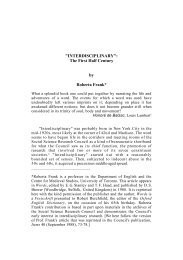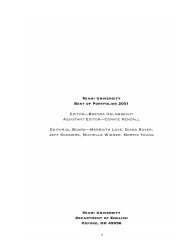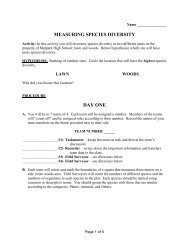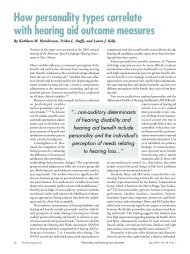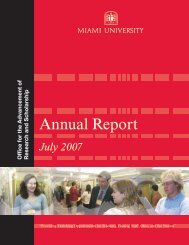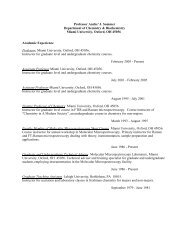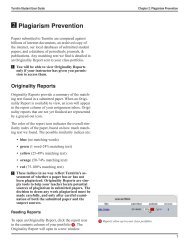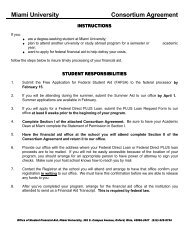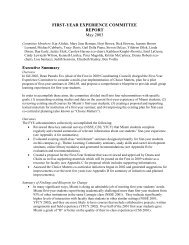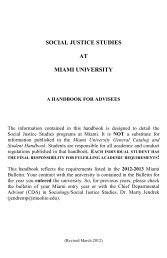Interdisciplinary Research Manual - Units.muohio.edu
Interdisciplinary Research Manual - Units.muohio.edu
Interdisciplinary Research Manual - Units.muohio.edu
You also want an ePaper? Increase the reach of your titles
YUMPU automatically turns print PDFs into web optimized ePapers that Google loves.
52<br />
Abstract. The abstract is the next page after the title page. Abstracts are singlespaced<br />
and should not be longer than a page; half a page is preferable. The point of the<br />
abstract is to offer a concise account of the project so readers can decide whether they<br />
want to read the complete project. Too often, the abstract is written at the last minute and<br />
in haste. Remember that it is a potential reader’s first look at the substance of the project.<br />
A sloppily written abstract suggests a sloppily researched and written project, so you are<br />
likely to lose readers if you do not proof read the abstract with care. Here’s a sample:<br />
ABSTRACT<br />
This project evaluates justice within the United States judicial system by exploring<br />
the definition of “crime” and the impact of this understanding on the way laws are<br />
formed, and then by discussing the most just response of a society to people who break<br />
these laws. An evaluation of the history of the United States penal system reveals that,<br />
though the response to criminal behavior in the United States has consistently revolved<br />
around punishment, the ways in which this punishment is inflicted have corresponded<br />
with economic and structural changes in society. The current popular use of incarceration<br />
as a means to punish offenders is unjust in that it does not create the maximum social<br />
utility that justice demands. The exploration of alternative methods of justice, such as<br />
restorative and rehabilitative justice, leads to a more specific discussion of the drug court<br />
in Franklin County, Ohio – the Treatment is Essential for Success (TIES) Program. The<br />
results of a preliminary case study conducted on the TIES Program suggest that success<br />
within the program, as defined by graduation, is strongly tied to the previous <strong>edu</strong>cational<br />
experience of the participants as well as to their use patterns in crucial phases of the<br />
program. Additional data suggest that future research will be able to predict more<br />
accurately which offenders are likely to succeed within the program and evaluate the<br />
efficacy of the program in r<strong>edu</strong>cing recidivism. By working at the root of criminality for<br />
these specific offenders in addressing addiction rather than punishing the results, drug<br />
courts such as the TIES Program result in greater justice and social utility for participants<br />
and for society as a whole.<br />
Acknowledgements. You are not required to include an acknowledgements page,<br />
but if you do it is the next page after the abstract. Remember that this page will be read<br />
not only by friends and family but (hopefully) by professionals in your field: your private<br />
comments to friends and family are on public display.<br />
Preface. Similarly, you are not required to include a preface, but if you do it goes<br />
after acknowledgements (or after the abstract if there are no acknowledgements). The<br />
focus of a preface is on you, not your topic. Feel free to reveal how you came to your<br />
topic, the experience of writing the project, or how it fits into your career or personal<br />
plans. But, as with acknowledgements, remember that professional readers and not just<br />
friends and family see what you reveal about yourself, and their impression of the<br />
seriousness of your scholarship can be shaped by what you say here.<br />
Table of Contents. This goes immediately after any preface, and should be<br />
confined to one page. Think of the table of contents, not just as a list of chapters and<br />
corresponding page numbers, but as an indication of how you have broken up the topic<br />
and organized your approach to it. For a savvy potential reader, it is the final test of



